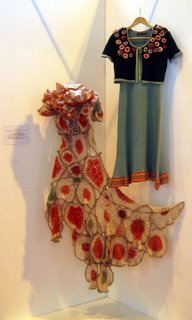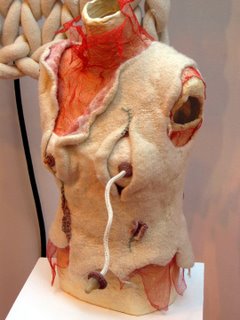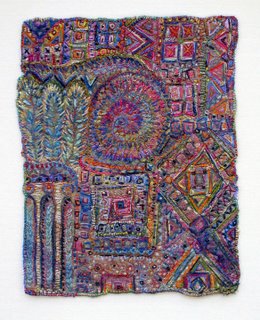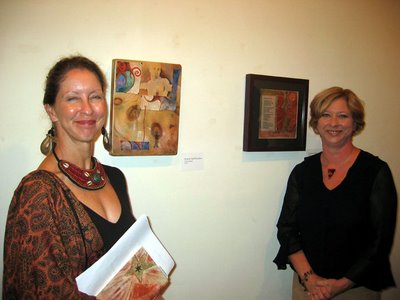Last night Sharon Licata, Alex, and I drove to Camden, SC for the opening reception of "Language and Landscape: Art and Poetry of Fran Gardner and Karen White" in the Fine Arts Center of Kershaw County. I'd been looking forward to this for well over a week. I was also hoping to congratulate Fran as the SC Arts Commission's Fellowship winner in the category of crafts. This part didn't happen but the show was wonderful nonetheless.
I've long admired Fran's work. I remember seeing it for the first time in the Governor's Mansion. This must have been five or six years ago. Somehow, Toni Elkins had suggested my name as an artist to create a one-of-a-kind Christmas ornament for the Governor's Christmas tree. It was the first year this was done. The "party" was hosted in the late afternoon by a local garden club. It seemed like an extension of the Junior League, but I was totally honored. There were only about six or seven artists asked. The idea was that six or seven more would be asked the following year. I really don't know if this was done again or not.
Marcelo Novo did an ornament too. It was something with artifical blue bird feathers. Later, he was selected to create an ornament for the National Christmas tree, along with Mana Hewitt, and others. (Memories could be blurred here, but basically this isn't the point!)
The point is, I made an ornament. It was polyester velvets soldered, in the form of a palmetto tree. It had beads. I really don't remember what it looked like, but I went to the reception. I saw another incredible fiber ornament. It was all free-motion machined zig-zag stitched. I couldn't resist; I touched it, turned it over, and admired everything about it. I memorized the name: Fran Gardner Perry.
In the spring I went to the Verner Awards with Connie Williams. Connie was on the SC Arts Commission's Board at the time. This was either my first time at the luncheon and art sale or my second time. I was a guest the first time. I was an artist the second time. Connie's daughter-in-law had already purchased Fran's work before I arrived. Had I come earlier, it would have been mine. It was a small piece on a wooden panel. Free-motion machine embroidery had been attached attractively with miniature nails. The tree-form was from Pritchard's Island. Fran went on the artist retreat the year before I went. I also learned that Fran was sister-in-law to then Governor Hodges. This was suppose to make a big impression on me. It didn't. I'd be much more inclined to say that former Governor Hodges has the rare distinction of being Fran's brother-in-law!
Later, I saw a black-and-white image that included three machine embroidered tree patches on one wooden panel. The image appeared in one of the last "Artifacts", a printed newsletter from the SC Arts Commission. Cost reductions did away with this publication, but I remember that the caption to Fran's work mentioned a major, national award. By this point, just the name, "Fran Gardner Perry", had become an icon for me, a symbol of talent, originality, quality, and remarkable fiber abilities. Like Lee Malerich, Fran was one of my personal "embroidery goddesses." I was in awe and wanted to humbly meet her.
About two years ago, I decided to write to Tom Ogburn, another artist who had lived in Columbia and been an aquaintance of mine. I own a one of Tom's works, a small wooden panel with a rhinosaurus on it. Kim Lemaster gave it to me for Christmas years ago. I wrote to Tom. I knew he was a close friend to Fran Gardner Perry. Later THAT VERY DAY, I went into my studio. Heidi Darr-Hope, Jeff Donovan, and a lady I didn't recognize were having a meeting about an upcoming joint show planned for the gallery. Unbelievably, this was Fran. I'd finally asked to meet her and was granted the opportunity even before my message had been read! FATE!
Since then, Fran went through a nasty divorce. She dropped the "Perry", got remarried, but kept her maiden name. She is now FRAN GARDNER. I will go out of my way always to see her work, to watch the images evolve, and to support her in any way possible. Sometimes, my admiration for an artist dwindles over time and repeated exposure. This is not and will never be the case with Fran's work. It speaks to me.
This was my favorite piece in the Kershaw County show. It was quite difficult to select a favorite because each is uniquely wonderful. Fran's transfers are mysterious, well done, and set my mind spinning with all their possible references. The stitchery is fine. The compositions are strong. When looking at one of Fran's pieces, I seem to be mentally transported into a crowded room of interesting people deep in multiple conversations. My mind cannot make out the languages or any one topic but my eyes seem to focus on the color, shape and suggestion of the visual art. The transferred drawing become alive. I am happily alone in a crowd. I am aware that no two people will look at the image alike. I am aware of beauty and an entire range of emotions. This is an experience that can never grow old.
I have to admit, I didn't look at Karen's collages with her poetry superimposed upon them. I liked the poems she read, however. Karen and Fran have traveled together and used these trips as inspiration for their separate work. They've shown together several times. Past journeys have been to New Mexico, Maine, New Brunswick, Nove Scotia, and to Europe.
I guess I'll end this long post where I started, the SC Arts Commission's Fellowships. The awards were announce on Wednesday. Fran has applied for thirteen years. Last year, we both received letters stating that the fellowship in the category of crafts was not going to be awarded because only four artists had applied. The board had decided that five were required, though nowhere on the website or application had this been written.
Fran and I wrote letters. We argued that the quality of work, not the quantity of applicants, be considered. I wrote to each commissioner. Fran wrote and made telephone calls to various staff people. We both informed Jeffrey Day of The State newspaper. We got the issue on last December's board agenda. I went to the meeting. I learned some disturbing facts.
Only nine artists applied in the category of Visual Arts. Only four applied in crafts. Only three applied in acting and one in directing. Thus, of six categories offered last year, only three were to be awarded. I fortunately never had to say a word. The board urged the staff to investigate why the numbers had dwindled so badly over the past several years. They voted to extend the deadlines and insisted that better communications with the state's artists be made. They voted to open the previous year's category in Dance too. (Dance only had three or four the year before. At that time, the board decided to require five. The board reversed this decision!)
As a result, there was a survey and a conference call. Basically, Fran and I felt like we'd opened a can of worms. Neither of us have any regrets about doing this. It was the right thing to do. Too many artists complain about the fellowship. The argument most often heard is that the award is now just $2500. Once it had been $7500, then $5000, then $2500, and finally $2000. This year it was up to $2500. My argument back to artists with this complaint was simple: We've all PAID to enter juried shows with prize funds totally less than $2500. It costs nothing to enter this!
Anyway, Fran did not get the fellowship again. She says that she's done applying. I hope not. But of us, however, wonder whether being "trouble-makers" was held against us. Artists are always complaining that the jurors are just out-of-state friends of the Arts Commission's staff. Basically, if you aren't on Harriett Green's list of "favorites", you don't stand a chance. There's plenty to complain about her influence; but, I just don't buy it. Sure, the jurors likely know our staff people but I can't see anyone risking their jobs and reputations over an award like this!
I looked up the jurors' backgrounds. There was a craft artist, functional clay; an administrator with a studio background in metals and jewelry; and a visual artist with a background in glass currently working in sculptural fibers. Sure, one also teaches and is married to another academic artist. Sure, both artist seem to have ties to the Alabama Arts Commission. Honestly though, it appears like a well-rounded group of qualified people. I also like the receiptants too.
Peter Lenzo of Columbia won in the category of crafts. He works in clay. The alternate, whose name slips my mind just now, also works in clay. In Visual Arts: PATTY BRADY won and Janet Orselli was the alternate. I just wrote about Patty two days or so ago. I like her work, admire her knowledge, and think highly of her personality too! What can I say? I guess, as pathetic as I am--even a trouble-maker--I'll apply again! The deadline is October 1!
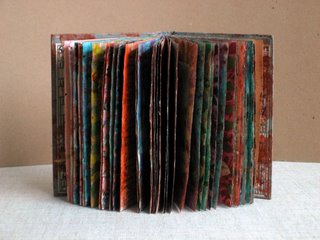 To the left: Man's Fate, altered book about extinction.
To the left: Man's Fate, altered book about extinction.





 This detail shot is part of a unique creation of knitted "rags" and strips of burlap and cotton by Aber Nasher. It is called "Body". The statement was great. Aber was influenced by bones and movement and believes that one's body outght to control a garment instead of the other way around. I couldn't agree more, though I don't think the outfit was one I'd wear with this notion in mind! In fact, the knots might hinder sitting or wearing a coat and would likely catch on things one would pass while walking. Still, the texture was most wonderful and the garment would certainly take viewer's eyes off of the wearer's body type! It definitely looked comfortable!
This detail shot is part of a unique creation of knitted "rags" and strips of burlap and cotton by Aber Nasher. It is called "Body". The statement was great. Aber was influenced by bones and movement and believes that one's body outght to control a garment instead of the other way around. I couldn't agree more, though I don't think the outfit was one I'd wear with this notion in mind! In fact, the knots might hinder sitting or wearing a coat and would likely catch on things one would pass while walking. Still, the texture was most wonderful and the garment would certainly take viewer's eyes off of the wearer's body type! It definitely looked comfortable!